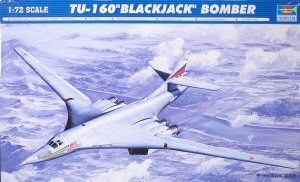
Trumpeter 1/72 Tu-160 Blackjack Kit First Look
By Michael Benolkin
| Date of Review | February 2006 | Manufacturer | Trumpeter |
|---|---|---|---|
| Subject | Tupolev Tu-160 Blackjack | Scale | 1/72 |
| Kit Number | 1620 | Primary Media | Photo-Etch, White Metal, Styrene |
| Pros | Nice cockpit, weapons bays, landing gear and overall engineering | Cons | Strange cruise missile issues (see text) |
| Skill Level | Intermediate | MSRP (USD) | $149.95 |
First Look
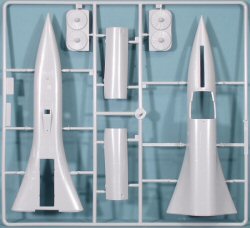 |
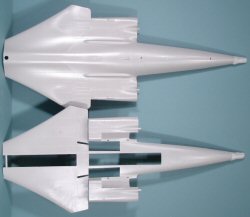 |
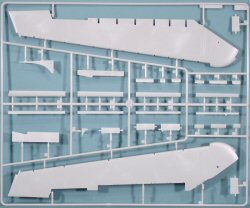 |
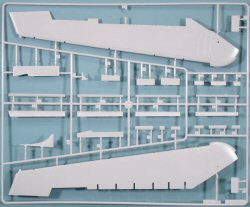 |
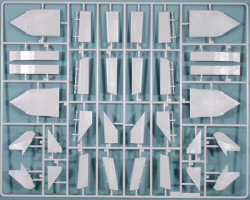 |
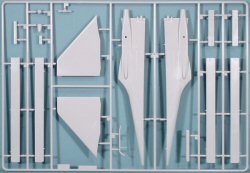 |
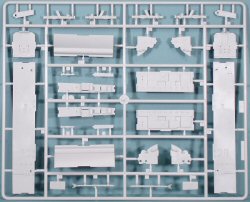 |
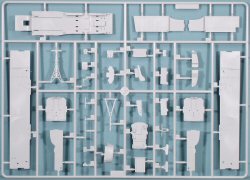 |
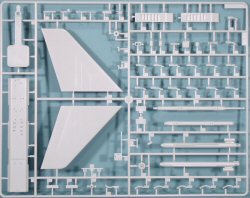 |
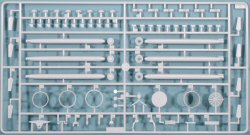 |
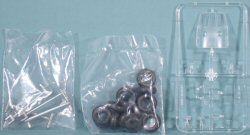 |
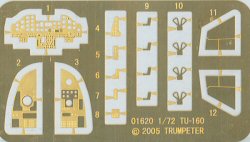 |
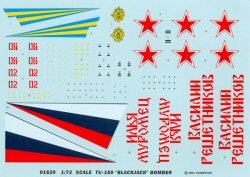 |
During the late 1960s, the Soviet Council of Ministers issued a directive for the development of a new strategic bomber. This directive, equivalent to the West's Request For Proposals or Invitation to Tender, was sent to the various design bureaus for consideration. Up until this point, military planners had been focused on the ICBM fleet and the only strategic bombers in the inventory were the Myasishchev M-4 Bison and the Tupolev Tu-95 Bear, both subsonic aircraft. Sukhoi's impressive T-4 (resembling the B-70 Valkyrie) was in the early stages of flight test when it had been summarily cancelled to focus on those very same ICBMs. With the USAF's intention to develop the supersonic B-1A bomber, it was time to counter.
At this time, only Sukhoi and Myasishchev OKBs responded and began development. Sukhoi advanced a derivative of the cancelled T-4, designated T-4MS, which was a very supersonic triangular lifting body with outboard variable geometry wings. This impressive design looks like something you'd see in the skies over Area 51! Myasishchev developed a number of variations based on a core design designated M-18 and M-20. Interestingly enough, the M-18 design was to become the basis for the Blackjack. The Tupolev OKB, which had been previously occupied with other responsibilities, was given the lead of a coalition of design bureaus that included both Sukhoi and Myasishchev OKBs. The Tu-160 was born.
While the aircraft bears a superficial resemblance to the B-1, the aircraft was developed and fielded as a Mach 2 strategic weapons delivery platform capable of delivering an array of nuclear and conventional missiles and free-fall munitions. The B-1A was similarly capable before being cancelled by then-President Jimmy Carter. The B-1B was intentionally performance-limited when it was returned to production by President Ronald Reagan to provide a strategic platform that wouldn't threaten the delicate détente that was being maintained. After the fall of the Soviet Union, many Tu-160s found themselves on Ukraine soil as those former Soviet Air Force Bases were absorbed into the fledgling Ukrainian Air Force.
I'm sorry, my usual WOW assessment of Trumpeter's new Tu-160 kit doesn't do it. Gobsmacked comes close. Holy s**t Batman!! does too. If you have any pre-conceived notion that this 1/72 kit was going to be small, let me laugh in your general direction!
Molded in light gray styrene, the kit consists of 621 parts and is presented on 13 parts trees (duplicate trees not shown) plus one small tree containing the clear parts. The upper and lower main fuselage halves are provided separately. The kit also includes a fret of photo-etch for cockpit details including an instrument panel that has a pre-printed acetate sheet with instrument faces provided. No photo-etched flight control hinges (thank you very much!). The landing gear is made up of white metal cores for strength (this is going to be one heavy model) and also includes two nose gear tires and twelve main gear tires - all rubber.
If I'm in shock over this kit, look at these details! The kit features a very nicely detailed four-place cockpit, weapons bay, wheel wells, landing gear, and basically everything else. Did I miss a memo or wasn't this aircraft a major state secret? Kudos to Trumpeter for recreating this aircraft in such detail and for not getting shot in the process!!
Okay, to business. The cockpit is a very nicely detailed affair with the main instrument panel rendered in photo-etch with acetate backing for instrument faces. The two rear crewmembers also have photo-etched panels and acetate faces as well. The cockpit floor also doubles as the ceiling of the nosegear well, so this assembly gets very busy on both sides.
Next up is the weapons bay and armament. The kit comes with 12 Kh-55 and 12 Kh-55SM cruise missiles. The Kh-55SM has conformal fuel tanks on the fuselage sides to extend the range of the missile, rendering a rounded triangular fuselage cross-section. The regular Kh-55 has a round fuselage. Now for some unknown reason, Trumpeter made the missiles about 1.4 times longer than the real missile. The Kh-55 series is 19' 3.5" long which translates to 3.22" in 1/72 scale. The kit missiles are 4.4" long. You can do the math- they're too long.
In addition, Trumpeter molded the engine of the Kh-55SM in the extended position (it is stowed in the fuselage until launch). To use the Kh-55SM, you'll need to remove the engine unless you want to pose one or more of these in flight. The Kh-55 has the engine stowed. Both missiles can be posed in the stowed or flight positions - parts are provided for the wings for flight and tail feathers in either position. Of course, if you're going to pose the Kh-55 in flight, you'll need the engines from the Kh-55SM.
Assuming you want to carry twelve cruise missiles in the weapons bay, the rotary launchers for the forward and aft weapons bays are assembled first. Next, with the cruise missiles of your choice, install them on the rotary launchers and mount these in their respective weapons bays. If you choose the Kh-55SM and forget to remove those engines, you should have a problem with getting the weapons bay assembled (there was a reason why those engines were stowed on the real missiles!).
Next up are the main wheel wells, engine intakes and exhaust nozzles. The afterburner chambers are a bit on the short side, but will do fine as-is with the details you'll see down the pipe.
The wings are movable. The flaps are positionable. You'd better make a decision early here! If you opt for the leading and trailing edge flaps deployed with everything hanging out, you'll want to glue the wings full-forward. The flaps are raised before the wings move on the full-scale aircraft, and if you accidentally sweep your model with the flaps out, you'll be making repairs to your wings and fuselage sides. If you have LOTS of shelf space, this model will look magnificent with the wings and flaps out.
With all of the various subassemblies complete, you install the forward and rear weapons bays to the lower fuselage half long with the main wheel wells and engine face plates. The cockpit is installed onto the lower nose half, which is glued to the lower fuselage half as well.
When you install the upper nose half to the upper fuselage half, you install the wings onto the lower assembly and mate the two fuselage halves together. Make sure you have plenty of room to maneuver the fuselage around as you glue the halves together. When I attempted the same thing with the Trumpeter 1/32 Su-27 fuselage assembly, I didn't see the cat on the corner of my workbench before I whacked him with a tail cone.
Wait until you see the main landing gear! As I mentioned earlier, the struts themselves are white metal, but they are enclosed inside hollow and detailed styrene struts. The horizontal crossmember is also white metal and is mounted to the strut so that it articulates. Onto this crossmember go the six axles/main wheels. If this landing gear assembly cannot hold the weight of this model (and the weight of several curious cats), then nothing will! Nice engineering here Trumpeter!
The final details are installed on the aircraft including the engine intakes, weapons bay doors, landing gear doors, tail assembly, engine nozzles, and canopy.
As the final step, you add the inserts to the inboard trailing edge of the wings and trailing edge flaps. These parts are flush with the wings and flaps in the take-off position and form a wing fence in the high speed, wings-swept position. While the reference I used is very well illustrated, there were no shots of the wings swept while the aircraft is parked, so I cannot determine if this is even an option, and if so, are these wing fences erected on the ground as well? The photos of the aircraft in flight show the fences up when the wings are swept.
There is a nice detail sheet in this kit covering two aircraft options. The first is bort 06 that has a stylized Russian Federation flag on the vertical stabilizer and a similar design on the nose containing the colors of the Ukrainian flag. The name "Ilya Muromets" appear on both sides of the nose. The second aircraft is Bort 02 with the classic red star on the tail and the name "Vasilij Reshetnikov" on both sides of the nose. A nice set of stencils are also provided on the sheet.
Each time Trumpeter releases one of these magnificent kits, I am amazed at the size and level of detail in each release. Each release also has a few challenges as well, and in this case, you'll need to pay attention to those wings. I'm not convinced of the strength of that wing sweep hinge. Also take note of the above cruise missile problems. Otherwise, this kit is going to look awesome when completed!
This kit is definitely recommended for the Soviet airpower modeler as well and for the bomber modeler!
My sincere thanks to Stevens International for this review sample!
References:
- Tupolev Tu-160 Blackjack, Yefim Gordon, © 2003 Midland Publication, ISBN 1-85780-147-4
- Soviet/Russian Aircraft Weapons Since WWII, Yefim Gordon, © 2004 Midland Publication, ISBN 1-85780-188-1







